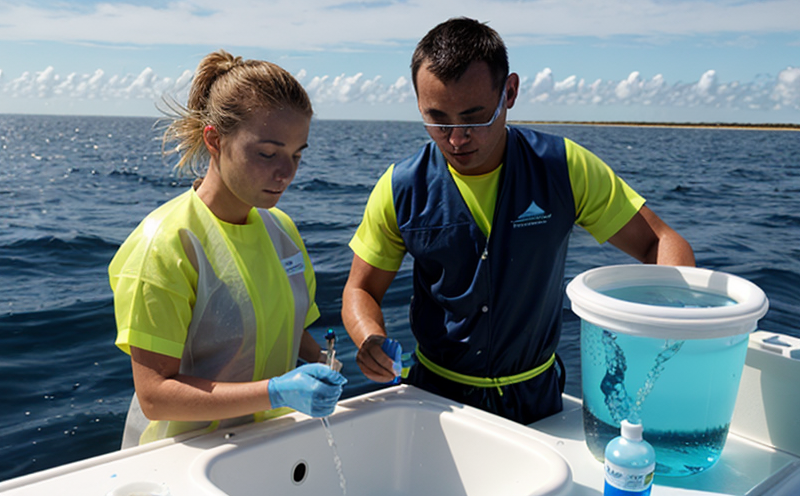ISO 7027 Turbidity Test in Seawater
The ISO 7027 turbidity test is a standardized method used to measure the optical property of water that interferes with the passage of light through it. This test is critical for ensuring the quality and safety of seawater, which plays a vital role in various sectors including marine biology, environmental monitoring, and drinking water treatment.
Turbidity itself refers to the degree to which a liquid loses its transparency due to suspended particles. In seawater, these particles can include clay, silt, algae, and other organic or inorganic matter. Accurate turbidity measurement is essential for compliance with international standards such as ISO 5667-1:2014, which specifies the conditions and procedures for the determination of turbidity.
The process begins by filtering a known volume of seawater through a pre-determined filter. The filter's pore size determines the particle size that can pass through. Once filtered, the sample is compared to standard solutions with known turbidity values using an nephelometer or similar instrument. This comparison allows for precise quantification and reporting.
The significance of this test extends beyond mere compliance; it ensures environmental sustainability by providing data on water quality changes over time. For instance, increased turbidity can indicate pollution from agricultural runoff or industrial discharge. Accurate measurements are crucial for effective remediation strategies and regulatory oversight.
- Customer Impact: Compliance with international standards reduces the risk of legal penalties and enhances reputation among stakeholders. Accurate data supports informed decision-making regarding resource allocation and operational adjustments.
- Sustainability: Reliable turbidity testing helps in monitoring ecosystem health, particularly in coastal areas where marine biodiversity is sensitive to water quality changes.
- Health & Safety: By ensuring that seawater used for various applications meets stringent quality standards, the test supports public health and safety.
In conclusion, ISO 7027 turbidity testing in seawater is a cornerstone of environmental protection and compliance. It provides critical insights into water quality that are essential for maintaining ecological balance and human health.
Scope and Methodology
The scope of the ISO 7027 turbidity test in seawater is to establish a standard procedure for measuring the optical property of seawater that interferes with light passage. This method ensures consistency and reliability across different testing environments, which is crucial given the variability inherent in marine ecosystems.
The methodology involves several key steps:
- Preparation of the Sample: Seawater samples are collected from specified locations using calibrated containers to ensure accuracy. Samples should be analyzed as soon as possible after collection to minimize any changes in turbidity.
- Filtration: The sample is filtered through a 0.45 μm pore size membrane filter to remove larger particles that could interfere with the measurement. This step ensures that only colloidal and suspended matter contribute to the turbidity reading.
- Measurement: The filtered sample is then analyzed using a nephelometer, which measures the scattered light intensity at 860 nm wavelength. Comparison against standard solutions allows for accurate determination of turbidity in NTU (Nephelometric Turbidity Units).
The results are reported according to ISO standards, providing a clear and unambiguous measure of water quality that can be compared across different locations and over time.
Customer Impact and Satisfaction
- Compliance: Ensuring compliance with international standards such as ISO 7027 is crucial for avoiding legal penalties and maintaining a positive reputation. Our precise testing services help clients meet these stringent requirements.
- Ecosystem Health Monitoring: Regular turbidity tests provide critical data that can be used to monitor the health of marine ecosystems, aiding in the identification of pollution sources and effective mitigation strategies.
- Health & Safety: By ensuring seawater quality meets or exceeds specified standards, our services support public health initiatives and safety protocols. This is especially important for applications like drinking water treatment and aquaculture.
In addition to these tangible benefits, our customers also experience enhanced satisfaction through:
- Accurate and reliable data that supports informed decision-making.
- Faster turnaround times, minimizing downtime for critical projects.
- Dedicated customer service providing tailored advice and support.
- A commitment to continuous improvement in testing methodologies and equipment.
The combination of these factors ensures that our customers receive the best possible service, leading to higher levels of satisfaction and trust.
International Acceptance and Recognition
The ISO 7027 turbidity test is widely recognized and accepted across numerous sectors due to its reliability and consistency. This standard has been adopted by organizations worldwide, including regulatory bodies, environmental agencies, and private companies involved in water quality management.
ISO 7027 is particularly important for industries that rely heavily on seawater, such as marine biology research, coastal engineering, and aquaculture. The test provides a uniform method of assessing water quality across different geographical locations, making it easier to compare data and establish best practices globally.
The widespread adoption of this standard also facilitates international collaboration in environmental protection efforts. By using the same methodologies for testing turbidity, countries can share data more effectively, leading to coordinated responses to environmental challenges such as pollution or climate change impacts.
Our laboratory is accredited to perform these tests according to ISO standards, ensuring that our results are not only accurate but also internationally recognized and comparable. This accreditation is a testament to the quality of our services and the confidence we can instill in our clients worldwide.





